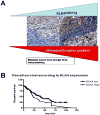Clinical significance of kallikrein-related peptidase-4 in oral cancer
- PMID: 25862839
- PMCID: PMC4577232
Clinical significance of kallikrein-related peptidase-4 in oral cancer
Abstract
Kallikrein-related-peptidase-4 (KLK4), a serine protease originally discovered in developing tooth with broad target sequence specificity, serves vital functions in dental enamel formation. KLK4 is involved in degradation of extracellular matrix proteins and it is thought that this proteolytic activity could also promote tumor invasion and metastasis. Recent studies have associated KLK4 expression with tumor progression and clinical outcome, particularly in prostate and ovarian cancer. Very little is known in regard KLK4 involvement in oral squamous cell carcinomas (OSCCs). Our objective was to investigate KLK4 expression in OSCC pathogenesis and disease progression. KLK4 expression was evaluated by immunohistochemistry, western blots and zymograms in OSCC lines. Invasion assays using high versus low/undetectable KLK4-expressing OSCC cell lines were performed jointly with KLK4 siRNA inhibition. A large collection of OSCC specimens was evaluated for KLK4 expression and correlation with patients' characteristics and outcomes were determined. Our data indicate that KLK4 is differentially expressed in oral carcinomas. OSCC cell lines with high invasive and metastatic potential have the highest levels of KLK4 expression. KLK4 mRNA and protein expression correlated with enzyme activity detected by zymograms. Inhibition of KLK4 expression results in diminished invasive potential in OSCC cell lines. Consistently, KLK4 expression is stronger in primary tumors that later either recurred or developed metastases, suggesting that its preferential expression in OSCC might contribute to individual tumor biology. Therefore, this study provides supportive evidence in favor of a prognostic value for KLK4 in OSCC and suggests that KLK4 could serve as a potential therapeutic target in patients with oral cancer.
Keywords: Kallikrein-related-peptidase-4 (KLK4); Oral squamous cell carcinoma (OSCC); cell lines; clinical outcome; invasion; metastasis.
Copyright© 2015 International Institute of Anticancer Research (Dr. John G. Delinassios), All rights reserved.
Conflict of interest statement
The authors declare no conflict of interest.
Figures


References
-
- Shah J, Johnson N. Oral Cancer. London: Martin Dunitz Press; 2003.
-
- Jemal A, Bray F, Center MM, Ferlay J, Ward E, Forman D. Global cancer statistics. CA Cancer J Clin. 2011;61:69–90. - PubMed
-
- de Bree R, Haigentz M, Jr, Silver CE, Paccagnella D, Hamoir M, Hartl DM, Machiels JP, Paleri V, Rinaldo A, Shaha AR, Takes RP, Leemans CR, Ferlito A. Distant metastases from head and neck squamous cell carcinoma. Oral Oncol. 2012;48:780–786. - PubMed
-
- Liao CT, Wang HM, Hsieh LL, Chang JT, Ng SH, Hsueh C, Lee LY, Lin CH, Chen IH, Kang CJ, Huang SF, Yen TC. Higher distant failure in young age tongue cancer patients. Oral Oncol. 2006;42:718–725. - PubMed
Publication types
MeSH terms
Substances
Grants and funding
LinkOut - more resources
Full Text Sources
Medical
